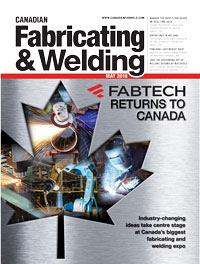Applications Engineer
- FMA
- The Fabricator
- FABTECH
- Canadian Metalworking
Take the guesswork out of welding dissimilar materials
How to choose the right filler metal and key best practices for your application
- By Caleb Haven
- May 15, 2018
- Article
- Welding

Welding dissimilar metals can present challenges that could result in issues with weld quality or cracking, so it’s important to choose the right filler metal for the application and follow key best practices to help ensure success.
The need to join dissimilar materials, such as mild steel to low-alloy steel or stainless steel to steel, is common in many industries and applications. However, many welders approach welding dissimilar materials with uncertainty, as they don’t understand what is required to make a sound weld between two different materials.
Indeed, welding dissimilar metals can present some challenges that can affect weld quality and lead to issues such as cracking. Choosing the right filler metal for the application and following key best practices can help ensure success.
Consider All Factors
A lack of knowledge is often the biggest hurdle in successfully welding dissimilar materials, and many welders may simply not know where to start.
If the filler metal isn’t metallurgically compatible with both base materials, it can lead to cracking or lack of weld strength. To determine the right filler metal and welding parameters, consider these key questions:
What are the materials being welded? In some applications, such as repair welding, it’s often difficult to know exactly what two materials are being welded. Having some idea of the materials’ chemistries is important; it helps fill in the blanks regarding the properties and characteristics. It is important to understand the base materials before any welding begins. Common ways to determine base material chemistry include performing a spark test, sending a material sample to be analyzed, and consulting with the original manufacturer or blueprints. Identifying the base materials allows you to select an appropriate filler metal based on their chemistries and mechanical properties.
What are the design requirements of the finished weld? Understanding the service conditions of the finished weldment is also important to determine the proper filler metal. For example, if the weldment will experience high stresses or high temperatures during service, the filler metal choice may be affected. If the filler metal has much lower strength or corrosion resistance properties than the base materials, the finished weldment might not be able to serve its purpose.
Is preheat required? The characteristics of each base metal also help determine the preheat and interpass temperature requirements. Two different materials may require different preheat temperatures, so knowing as much as possible about the base metals helps determine the best preheat temperature. Each application should be individually evaluated. A rule of thumb, though, when welding together materials with different preheat recommendations is typically to use the higher recommended preheat.
Some dissimilar-metal welding combinations are common. Consider the following best practices to achieve the best results.
Welding A36 to A514
The combination of these two steels is often found in structural, construction, and heavy equipment welding. A36 is a low-carbon steel that offers good strength and formability. A514 is a high-strength steel, typically offering a yield strength of 100,000 PSI, depending on the grade.
A guideline for joining two steels of different strengths is to choose a filler metal based on the strength of the lower-strength material. This is because the strength of the weldment will never be greater than the lowest strength member. In this case, the filler metal choice would be based on the properties of A36 steel. An American Welding Society (AWS) E7018 low-hydrogen stick electrode, ER70-6 solid wire, and E71T-1 flux-cored wire are good options to consider for welding these two materials.

Joining a 3XX series stainless steel, such as 308, 309, or 316, with carbon steel is a combination found in many applications, including piping and structural welding.
While filler metal selection is based on the lower-alloy metal, it’s recommended to use the preheat and interpass temperature recommendations for the higher-strength material, which in this case would be A514. This is because proper preheat and interpass temperatures are more critical for the higher-strength metal. Not using the proper preheat and interpass temperatures can lead to problems such as cracking and loss of strength in certain materials.
Welding A36 to 4130
A36 steel is commonly joined to AISI 4130 — a low-alloy steel that contains molybdenum and chromium as strengthening agents — particularly in heavy equipment welding. AISI 4130 is commonly used for components such as shafts and machine components.
Again, the filler metal choice generally depends on the strength of the lower-alloy base metal of the two. Low-hydrogen filler metals that provide 70-KSI tensile strength, such as E71T-1 flux-cored wire and E7018 stick electrodes, are typically good choices for dissimilar-material welding applications involving A36 steel.
Additional care should be taken to ensure that proper preheat and interpass temperatures are followed for the 4130 material. This will depend somewhat on the heat-treatment condition of the material. Generally, it is recommended to weld 4130 in the annealed condition.
Welding A36 to AR Plate
Abrasion-resistant (AR) steel plate typically is more resistant to abrasive wear than steel or low-alloy steel plate, so it’s often used in heavy equipment and mining equipment applications. AR plate may be used inside the bed of a dump truck, for example, to extend service life in harsh conditions. AR plate typically is a quenched-and-tempered low-alloy steel that is rated for use only as wear plate.
Applications that require joining A36 steel to AR plate generally are straightforward but may require a little background work before welding begins. Since there is no industry standard that governs the makeup and processing of AR plate, each steel plate manufacturer may make AR plate differently. As a result, the chemical and mechanical properties of this material often vary by manufacturer and, therefore, can have different preheat requirements or filler metal recommendations.
While 70-KSI filler metals such as E7018 electrodes often are adequate in this dissimilar welding application, it’s recommended that you contact the AR plate manufacturer whenever possible for details about the makeup of the plate and specific filler metal and preheat requirements.
Welding Stainless Steel to Carbon Steel
Joining a 3XX series stainless steel, such as 308, 309, or 316, with carbon steel is a combination found in many applications, including piping and structural welding. Stainless steel often is used when only certain portions of the structure or weldment require corrosion resistance or heat resistance; stainless steel can be used for those portions while carbon steel is used for the remainder.
A 309 stainless steel filler metal is typically a good option for this combination because it helps improve crack resistance and provides the appropriate chemistry for the weld. Because of its chemistry, stainless steel is more susceptible to distortion than steel. Therefore, it’s recommended that you keep the heat input as low as possible when joining stainless and carbon steel.
Best Practices for Success
Many welders may not be familiar with the proper practices for joining dissimilar materials. A good place to start is determining what type of materials are being welded, whether it’s mild steel, high-carbon steel, low-alloy steel, or stainless steel. Having as much information as possible regarding the material specifications and characteristics is critical to success. Choosing the right filler metal and using proper heat inputs all depend on the type of materials being joined and the service requirements for the finished product.
Caleb Haven is an applications engineer, CWI, at Hobart, www.hobartwelders.com.
About the Author
subscribe now


Keep up to date with the latest news, events, and technology for all things metal from our pair of monthly magazines written specifically for Canadian manufacturers!
Start Your Free Subscription- Industry Events
MME Saskatoon
- May 28, 2024
- Saskatoon, SK Canada
CME's Health & Safety Symposium for Manufacturers
- May 29, 2024
- Mississauga, ON Canada
DiPaolo Machine Tools Open House 2024
- June 4 - 5, 2024
- Mississauga, ON Canada
FABTECH Canada
- June 11 - 13, 2024
- Toronto, ON Canada
Zoller Open House & Technology Days 2024
- June 12 - 13, 2024
- Ann Arbor, MI





















